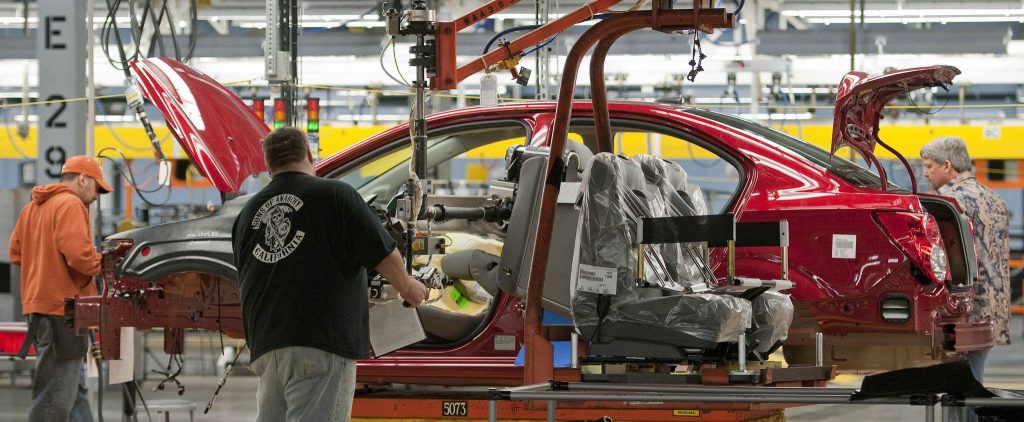When Henry Ford introduced the Model T, the United States became the epicenter of a global automotive boom. Cars, jeeps, ambulances and tanks figured tremendously in both war and peace, and yielded industrial advances that employed millions of Americans.
[George Boyd Jr. | August 1, 2018 | Morning Consult]
Essentially, the automobile became the hub of the modern industrial age. The steel, the electronics, the rubber, the petroleum, the plastics — all of these inputs combined to provide thousands of components for the modern car.
Auto parts matter even more than a finished car. That’s because auto parts employ millions of skilled workers in a wide range of industries. Unfortunately, times have changed. America’s auto parts chain is now failing, thanks to predatory trade from countries like China and Japan.
From 2000-2010, the US lost 400,000 auto parts manufacturing jobs. And in the same period, the US auto parts trade deficit with China grew from $9.5 billion to $31.2 billion.
Why is this happening? Part of it comes down to unfair trade practices. Both China and Japan have intervened in global markets to lower the value of their currencies — which makes their auto parts exports artificially cheap in the US market. But China’s auto parts industry has also received many billions of dollars in direct government subsidies.
The situation is getting worse. Once the world leader in auto parts, America’s auto parts chain now supplies only 20 percent of the U.S. market, and a minuscule 4 percent of the world market.
In the automobile sector, the data is equally troubling. From 1990 to 2017, U.S. auto assembly employment fell 22 percent. U.S. vehicle manufacturers now account for only 20 percent of global auto research and development.
The trend is not encouraging, and without concerted action from Washington, America stands to lose its auto parts sector entirely — including the remaining 586,000 skilled, good-paying jobs that the industry supports.
The Trump administration is paying attention, though, and recently announced a section 232 trade investigation of auto parts from Europe and Asia. The Commerce Department is examining whether auto parts are “being imported into the United States in such quantities or under such circumstances as to threaten to impair the national security.” Commerce is also considering whether escalating automobile and auto parts imports are adversely impacting research and development, skilled jobs, and key high-tech industries.
The national security consideration comes from America’s auto parts supply chain connecting to both civilian and military production. America’s armed forces rely heavily on automotive equipment, motors, chassis, and finished vehicles for ongoing operations. Supplying vehicles and parts remains a critical part of operational readiness. And so, the same auto parts chain that equips passenger cars also supports jeeps, tanks, amphibious vehicles, and troop transports.
My family has worked at Goldens’ Foundry & Machine Company, in Columbus, Ga., for five generations. And Goldens’ offers a good example of just how intertwined civilian and military production are in the United States. At the start of World War II, we were producing both textile machinery parts and sugar cane mills. But the U.S. Maritime Commission needed Goldens’ to produce steering engines for Liberty Ships — known as the “Ugly Ducklings” of World War II. While this wasn’t work we had done before, we knew how to melt iron and make machine castings. The government showed us how to produce, test, and assemble the steering engines. In a very short period of time, we were in full production. And so, during the war, Goldens’ was almost exclusively devoted to military production, manufacturing more than 500 steering engines. After the war, our foundry and machine shop returned to civilian customers. But from then on, Goldens’ has been manufacturing highly engineered products for transportation and heavy industry.
In the grand scope of World War II, Goldens’ production played a small part. But that’s really the point. America’s national defense requires not only the participation of our biggest manufacturers, but also the efforts of thousands of other much smaller manufacturers throughout the supply chain. And this same interconnectedness and expertise exists among auto parts producers throughout the nation. They offer good-paying jobs and skilled work that are essential to supporting both a strong manufacturing base and our national defense.
The president is right to focus on the national security implications of the United States losing its automotive industry. In 1941, the United States was able to call on its automakers, parts suppliers, foundries and machine shops to provide the materials necessary for the war effort. In a time of crisis, we have the equipment, expertise and skilled workforce to convert from cars and sugar cane mills to tanks and steering engines. As a nation, we can’t expect to be able to import these things in a time of need. The potential cost of these cheap imports is simply too high. A United States without a vibrant automotive industry is a troubling scenario, and one that Washington should strive to avoid.













